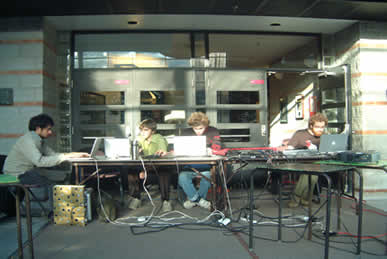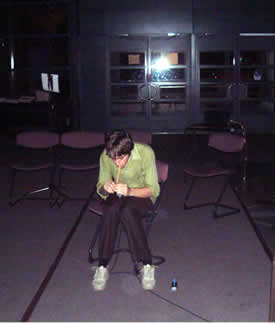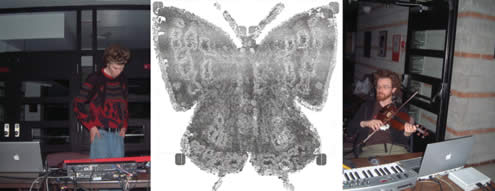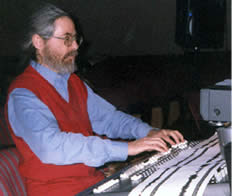Butterfly Installation Instrument
“Lady butterfly,
I saw you a week ago.
Now you are back,
With your lover,
In tandem flights
And helical tangents:
How many times
You return gladly!”

~Audio Artists~ Video Artists~ Equipment~
Joshua Zubot ~ Logic, Oxygen 8, Violin / Tim Sutton ~ MAX/msp Jitter, Bidule
Philip Karneef ~ Reaktor, Nord Modular / Ludwig Nemomen ~ Arkaos, UC-33 E
~Additional Equipment~
2 x 5.1 Amps
10 x Small Speakers 2 x Multi Output Soundcard
2 x Prepared Video Projectors
Four Apple Powerbooks
“In the legends there is the story of the butterfly lovers.
They loved each other so much that even in death,
Their hearts were fixed faithfully upon one another.
In honor of their devotion to each other,
The gods changed them into butterflies
And let them come back together
In reincarnation after reincarnation.”
~Butterfly Installation Instrument~
The Butterfly Installation Instrument was originally designed to accompany The EuCuE XXIII (of a series) Concerts held at the Oscar Peterson Hall at Concordia University in Montreal. In it’s EGG stage it was a non-interactive, indoor installation whose equipment consisted of 10 small loudspeakers, amplifiers and 5 CD players placed with plenty space through which the audience/listeners could circulate easily and freely.
The CD players would be set to a random mode. Tracks were in stereo, with different content on the two channels, creating ten real sources, while the CDs would play continuously, creating a truly unique (and relatively unpredictable) audio environment experience. This technique, however, required too much hardware for what the desired effect yielded, and eventually underwent a minor, yet ultimately much broader revision, employing the use of a laptop and a multi-output soundcard.
~Harvest Moon Revisited~
[Wednesday and Thursday]
For the November EuCue Concerts, the Butterfly was taken to another stage in its cycle. The accumulated electroacoustic work’s from the initial installation was used in a MAX/msp patch. Written exclusively by a Concordia student to stand alone, and deliver a jukebox array of original material, now completely random.
There was a new concept for speaker placement as well, one which saw the Oscar Peterson foyer as an environment in which to exploit the reflectivity and spatialization potentials. One would hear something entirely different from another person standing only 5 feet away. This was due largely to the speakers facing into walls, up to the ceilings, and at other unconventional points. A new addition to the set-up was a microphone set through a synthesizer, using vocoding and physical modeling, it’s placement acted as an open invitation to passers-by. This device brought an interactive element that indeed offered itself to many captivating improvisational moments.


~Instrument of Improvisation~
[Friday, November the 19th]
The overall emphasis on this, the last day of the concerts, was, in all ways imaginable, improvisation.
In which, four students performed live audio /visual work for nine solid hours. This sonic environment, or body of the butterfly itself, fluttered giant wings “in tandem flights and helical tangents”. With patterns that were dazzling to both the eyes and ears, this truly represented the LARVAE stage of the butterfly in full effect. The overall feeling was caterpillar-like to say the very least, low and rumbling movements to the left, high shrills and snips of conversations to the right and no common center playing any part at all.
With this movement scattered about the room, and the multiple speakers no longer reflecting off the walls exclusively, but off of people involved in the performance and their freshly placed equipment, the ensuing improvisation was much more abundant than any of it’s participants could have estimated.
~Video Eyelectroacoustics~
A breakthrough for the piece itself was the use of data projectors in abstract ways. There was no wallpaper or VJ-styled imagery to be seen. Moment by moment code writing, use of patch building programs, and even real-time layering was all taking place. A host of other simple tricks helped give the room a wealth comparable to that of the audio counterpart. Some of these visual devices included; Video feed back , the use of reflections to mirror and split the moving images , on the fly video recordings, and one anonymous individual shutting down the majority of the atrium lights with a small pen knife. These mixed up video examples, based on surrounding events, were also reused in real-time through programs to give a slightly familiar or current feeling to the viewers and creators alike. This aspect of the performance was, at the most surreal times, caught in the very act of remixing itself, as it were.

~Resetting A President~
A brief yet poignant moment ensued part-way through the performance, when faculty head and Butterfly curator Kevin Austin, graced the microphone with various mouth made whistles, chirps and squeak sounds to a crowd of fascinated spectators. This very act was a highlight for creator and witness alike, as it opened so many minds to the vast possibilities of subtle artistic interactivity. In essence, the capacity for one individual or moment to help shape the direction of the butterfly environment, via many alternatives, was really what made this installation successful. In all aspects, the changes that would take place throughout the performance ranged in accordance with simple daily situations like; a class filling then leaving the foyer, friends of performers occasionally sitting and talking to them, causing another to pick up the pieces with more effort, even the sun setting had a large effect on how the room acted. As the night came to a close,
when the final stragglers left the EuCuE Concerts, there was still a verbal creativity that seemed to linger, with conversations aplenty, and ideas spun ‘round, one felt as if the installation itself had simply opted to change form into another stage of it’s process, a temporary stasis in introspective hibernation, for a term.
~Stages of the Butterfly~
With the chrysalis stage to follow in this unparalleled Butterfly Series, one can only imagine what it might be like to be a PUPA wrapped up in an electroacoustic audio/visual cocoon… while suspended in mid-air…

Original Concept and Diagrams by Kevin Austin
All Rights 2004
“Would that all of us could manifest such determination and faith to what we love!”
Determination
365 Tao #272
STUDENT FALL2004
BENJAMIN EAMT 205
HENDERSON ID 5146053
REFERENCES

Stages in the Life of a Butterfly
Egg
Butterfly eggs consist of a hard-ridged outer layer of shell, called the chorion. This is lined with a thin coating of wax, which prevents the egg from drying out before the larva has had time to fully develop. Each egg contains a number of tiny funnel-shaped openings at one end, called micropyles; the purpose of these holes is to allow sperm to enter and fertilize the egg. Butterfly and moth eggs vary greatly in size between species, but they are all either spherical or ovate.
Butterfly eggs have a hard outer shell. This protects the larva inside. The shell is called the chorion. Inside, the egg is lined with wax. This keeps the egg from drying out. Not all eggs are the same shape or size.
Larva
Larvae, or caterpillars, are multi-legged eating machines. They consume plantleaves and spend practically all of their time in search of food. As they mature their skin is shed several times
Larvae have three body parts-head, thorax and abdomen. Even though the caterpillar has 6 eyes, it can't see very well. The antennae help guide the larva. They breathe through holes in the side of their bodies. Larvae have a set of real legs and five false legs called prolegs.
Pupa
When the larva has eaten enough it will form a chrysalis (Butterflies do not spin cocoons, moths do.) The larva usually moves to the underside of a leaf. To form a cocoon it spins a silk-like thread around itself. A chrysalis is formed by hardening bodily secretions. A larva completely covered by a cocoon or chrysalis is called a pupa. Inside its protective shell the larva will transform into a butterfly (or moth), a process known as metamorphosis.
As the larva pupates, it splits the exoskeleton and the larval skin comes off. When the skin is part of the way off, the cremaster appears. It is a spiny part at the end of the abdomen that the baby butterfly hangs from until it is strong enough to fly.
Adult
The adult, sexually mature, stage of the insect is known as the imago. As Lepidoptera, butterflies have four wings, but unlike moths, the fore and hindwings are not hooked together, permitting a more graceful flight. A butterfly has six legs; the larva also has six true legs and a number of prolegs. After it emerges from its pupal stage it cannot fly for some time because its wings have not yet unfolded. A newly emerged butterfly needs to spend some time 'inflating' its wings with blood and letting them dry, during which time it is extremely vulnerable to predators.
Many species of butterfly are sexually dimorphic. Some butterflies, such as the Monarch butterfly, are migratory.
Butterflies are often confused with moths, but there are a few simple differences between them, including colour, habits, and pupating appearance. See the difference between a butterfly and a moth.
Butterflies live primarily on nectar from flowers. Some also derive nourishment from pollen, tree sap, rotting fruit, dung, and dissolved minerals in wet sand or dirt. Butterflies are also pollinators.
The adult butterfly has three body parts-head, thorax and abdomen. It also has 6 legs but it curls up the front ones so sometimes people think there are only four. Butterflies have a proboscis, which is a long straw-like tonque, which it can use to suck up nectar and water. There are two sets of wings-hindwings and forewings.
Social top